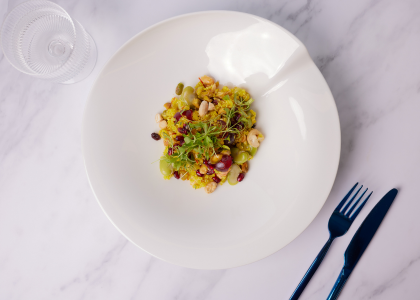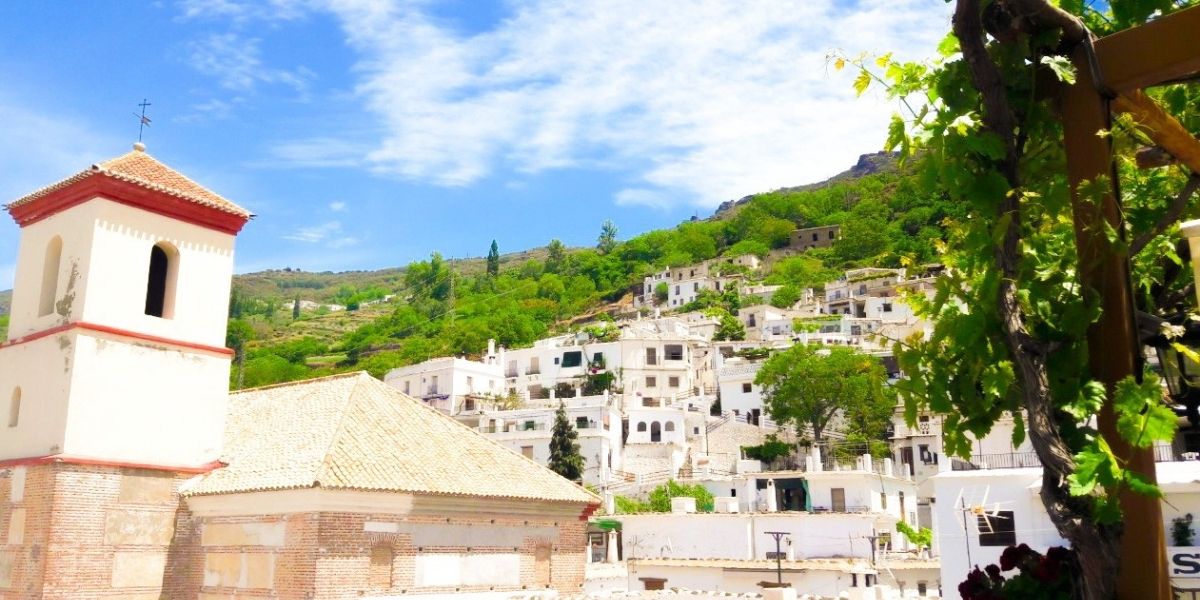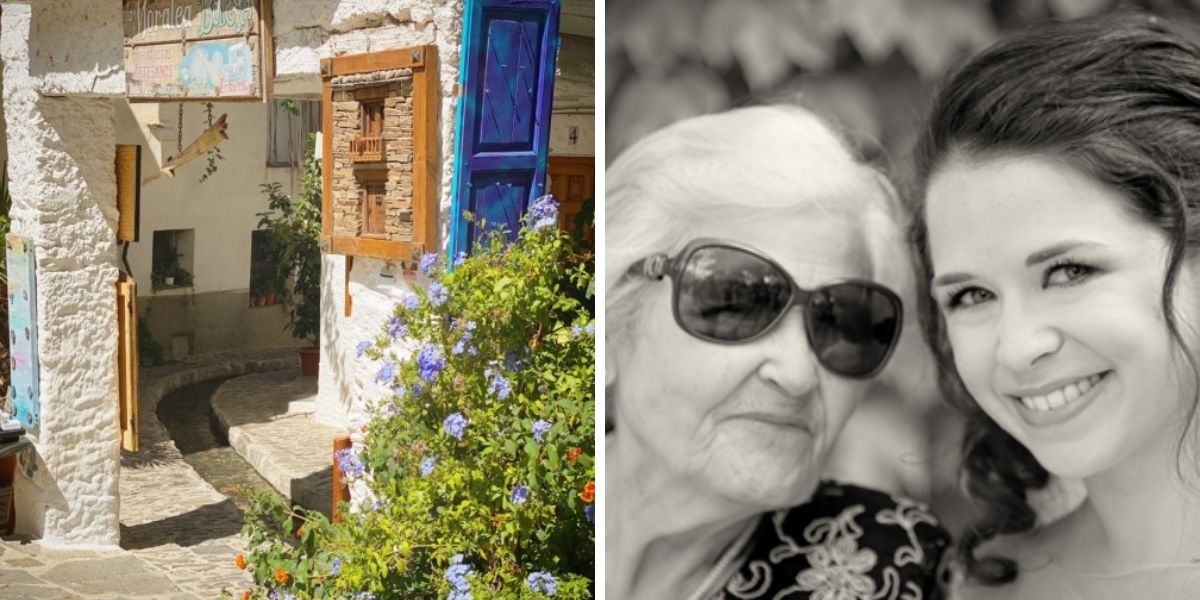
A plant-based recipe to celebrate great chefs around the world
This International Chef's Day, we're raising a fork to the hard-working and passionate chefs across the world, including Le Cordon Bleu chefs in training, ...
By Susie Corley

Sitting in the middle of a beautiful restaurant just off Plaza Bib Rambla, Abuelita lifts her skirt to fan herself, flashing an alarmingly large pair of starched white knickers. She grabs the waiter by the sleeve and rudely demands a drink, in the voice of a petulant child.
We’ve just finished our tapa of pinchos morunos, tender cubes of Moorish spiced pork, made more delicious by the fact that we don’t have to pay for it. (Granada is one of the last places in Spain to provide free tapas with your drink.)
“There’s too much cumin, chica, it smells like an old man’s armpit” complains Abuelita.
Abuelita means ‘Little Grandma’ in Spanish, but there is nothing little about her character. She is a Grandmother, travel companion, self-proclaimed ‘best cook in Granada’ and the literal embodiment of everything you imagine a 90-year-old Spanish grandmother to be. Eating my way round the province of Granada with Abuelita has been a labour of love; heavy emphasis on both the words ‘labour’ and ‘love’.
I hand the waiter money for our drinks along with an apologetic smile, as we depart towards the Albaicin, Granada’s enchanting Moorish old town. At just over 5 foot tall, like myself, we move our little legs quickly, disappearing into the busy cobbled streets. Abuelita’s legs betray little of her age, as she recalls the dishes of her childhood, the streets perfumed by jasmine, incense and spices. The promise of flavours still to be enjoyed.
Born and raised in the UK, I spent every holiday visiting Abuelita in my mother’s hometown of Granada, where cooking was an expression of love as well as sustenance. My memories of those meals from my childhood remain: sweet clams in sherry, hearty goat stews and churros dipped in thick hot chocolate.

After graduating from catering college, my culinary identity felt scrambled with chou farci and choux pastry; my cooking has always felt closer to the dishes of my Spanish relatives than the haute cuisine of French chefs. I felt the urge to rediscover and replicate the flavours of my childhood.
As my Spanish culinary consciousness awoke, I began to notice what was not being noticed: Granada. In recipe books and travel guides, no one mentioned the food of Granada. A grave omission, surely. Some 2.7 million tourists visit the Alhambra each year, making it the single most popular monument in the whole of Spain. Few tourists, however, venture further.
I therefore committed myself to a culinary journey of discovery, to uncover Granada’s local dishes at their finest. A pilgrimage of sorts.But Granada falls victim to its own charm; the province has an understated and authentic appeal that allows it to be overlooked. Much like the pomegranate, the fruit from which Granada derives its name, its treasure is revealed upon closer inspection. To better inform my quest to uncover the secrets of Granada’s culinary heritage, I enlisted the help of the resident expert: Abuelita. With little plans aside from napping and watching telenovelas, she willingly obliged.
Our method of eating our way round the province of Granada is simple: I try something new, Abuelita orders the cod and complains about it. She could always have cooked it better.
Sometimes this is indeed true; Abuelita is an exceptional cook, honed through decades of cooking for her 5 children. She is a veritable oracle of Granadino cuisine, recommending the best dishes to try, despite her own aversion to adventurousness. She lost a finger as a child in a tragic — try not to laugh — sausage machine accident; I’m convinced the remaining stump imparts a magic flavour to her cooking.
She grew up during some of Spain’s most turbulent periods, living through the civil war, subsequent oppression and alienation, and raising a family under Franco’s dictatorship. A qualified and hardy companion.
We begin in the city, before travelling south through the mountains and finishing at the coast.
Starting in Granada’s Abaicin, Abuelita and I arrive at the restaurant Mirador de Morayma. A series of terraces unfold, sheltered by fig trees, fountains providing a soundtrack of running water. The view offers just reward to the weary traveller: one of the best views of the Alhambra in all of Granada. Befitting of its setting, the restaurant offers dishes redolent of the city’s Moorish heritage.
Abuelita places the order, and a plate of remojón granadino arrives, an orange and salt cold salad. Bitter leaves balance the flavours of soft, salty cod and slivers of black olive, tempered by the juicy sweetness of orange and crescents of hard-boiled egg. Next follows suckling pig, caramelised apples and black pudding, fragrant with ground coriander, cumin and paprika. We finish with a tray of conventos dulces, small cakes made with almond flour and aniseed from the neighbouring convent.
Abuelita dips one of the cakes into a cup of manzanilla, a traditional chamomile tea, and explains that desserts were unheard of in her childhood. Quite simply, they were a superfluous indulgence they could not afford. Eggs, milk and butter were not forthcoming and were seldom used. Fresh fruit, of which Granada has a bountiful larder, was offered instead. I remember bowls of plump strawberries macerated in sugar and fresh, pulpy orange juice from my own childhood visits, its refreshing lusciousness shrouded at the time by our childish entreaties for cheap ice cream from the nearby kiosk. Abuelita recounts that on special occasions, such as her Saint’s day, her parents might bring home some roscos de aceite, baked by the nuns nearby. These dry biscuits, made with oil and scented with cinnamon, were a treasured, sporadic luxury.
For a moment, as she reminisces, I imagine her white hair turning back to its youthful jet-black and her wrinkles smoothing to reveal a once remarkable Mediterranean beauty. She still wears the same black dress with a delicate red flower print, immaculately maintained despite a lifetime of use.
As I savour the last morsel from our tray of dulces, I feel a bit of the tranquil paradise the Moorish kings sought to inspire when they built the Alhambra centuries ago, before being brought back to earth by the sight of Abuelita mistakenly heading into the men’s toilets.
We head next to the Sierra Nevada mountain range, home to a group of villages known as Las Alpujarras. Winding streets open onto quaint squares, lined with white washed buildings adorned with bougainvillea and ethereal flowers of coral and Persian blue.
We stop at Ruta de Mulhacen in Pampaneira, ascending the steep stairs that grant the restaurant’s terrace a view of the mountains and the distant Mediterranean. Abuelita begrudges the climb — her prerogative as a nonagenarian — and promptly sits with her back to the view. I drink in the view with pleasure, vibrant viridian leaves of almond and olive trees set against the scorched terracotta earth and turquoise sea in the far distance.
The cod, this time, is obscured by a thick sauce of almonds, scented with saffron. Naturally, it is not seasoned to Abuelita’s liking (she’s been known to drain a saltshaker in one sitting.) In reality, it is impeccably seasoned, allowing the natural flavour of the cod to flourish. The dish serves as another invocation of the Moorish influence; both almonds and saffron were introduced by the Moors during their long occupation of the region. Abuelita’s own kitchen is also a welcome home to saffron, cinnamon, nutmeg, aniseed and other Moorish intimations; her cooking is inextricably bound to a food history long passed.
“Try the migas, chica” suggests Abuelita. Migas is a peasant-style dish made of semolina, or in this case breadcrumbs, fried liberally in pork fat and shards of sweet garlic. Paprika-rich chorizo and black pudding are added, and more surprisingly, chunks of ripe melon. After spotting my surprise at the addition of melon, Abuelita confidently assures me that the melon is essential. She is undoubtedly right: the dish is salty and moorish, and the melon is a welcome palate cleanser. Elegant it is not, but the subtlety and humility of local food is palpable.
I am learning that these humble dishes are the true character of Granadino cuisine. While frugal ingredients such as pulses and stale bread are often synonymous with blandness, here they are transformed into dishes that are flavoursome and generous. I am reminded of a dish Abuelita cooks regularly, olla de San Antón, a stew of white and broad beans enriched with cheap cuts of pork, such as the tail and ears. It sounds unfashionable at best and off-putting at worst. But this is not food for your tourist attraction-adjacent restaurant. This is wholesome, nurturing, family fare.
How does she make it taste so good? Patience and provenance, replies Abuelita, in her own words. Chickpeas and beans are soaked overnight, not bought in tins, then cooked slowly. Add just a little meat for flavour, but only if it is local. A lesson in both sustenance and sustainability.
Our tour of the province ends at the coast, in the town of Salobreña. We enter El Peñon, which is perched on a rocky outcrop, the waves of the vast Mediterranean blasting brazenly beneath us. Inside, however, all is calm — with the exception of Abuelita, of course. There is a tantalising smell of fresh shellfish being grilled, which she helpfully suggests they should obscure with air freshener.
Outside the restaurant, in an old fishing boat, a charcoal fire burns. Hanging over the top is a row of octopus, a tangle of tentacles transforming into crispy pulpo a la brasa, the very dish I intend to order.
Abuelita orders her cod a la romana, which is fried in an impossibly light batter, encasing sweet flakes of flesh. The British in me wants to steal her plate and gorge myself on deep fried fish. Sense prevails, however, and I proceed with the octopus which is somehow both tender and crispy. Squid ink aioli comes as a powerful companion. Abuelita advises me that “squid ink is too pungent, chica, simple paprika is better”. Perhaps she is right: in the spirit of my culinary education, I embrace her suggestion of simplicity.
At last, I spot a glimmer in her eyes. She has spotted her favourite dessert. We immediately order the tocino de cielo, a traditional flan-like pudding with rich caramel. Her spoon perched between thumb and the stump of the missing finger, she is miraculously, wondrously, inexplicably silent… and satisfied. What does tocino de cielo translate to in English? Heavenly bacon.
Whilst travelling with Abuelita is both trying and treasured, my appreciation for Granada remains unwavering and my culinary inspiration restored. The food is a little like Abuelita, somewhat old-fashioned and not exactly refined, but therein lies its charm. It is a generous, colourful and wholesome expression of love. Miles away from the tourist traps selling boozed-up Brits burgers and English breakfasts, it leaves you comforted and satisfied.
My own cooking will be forever altered. I’m beginning to embrace the robust staples of frugal cooking and fresh produce of local provenance. With every chickpea, lentil and butter bean I cook, I will think of Granada and do it with a little love and a touch of Moorish spice. As Shakespeare once said, “All curious travellers keep Granada in their hearts.” I will keep it in my heart and in my kitchen.
About the author: Chef and food writer Susie Corley established Sobremesa as a home for lovers of Spanish food and local produce. Sobremesa hosts supper clubs, as well as being a source for authentic Spanish recipes and food stories. Inspired by the food of her Spanish relatives, Susie trained in cuisine at Le Cordon Bleu before moving back to the Cotswolds. She now splits her time between cooking, writing and raising her two young children.
You can find more information on her website and social media: www.sobremesakitchen.co.uk / @sobremesa_kitchen.
This article is the work of Le Cordon Bleu Online Learning 10-Week Food Writing for Publication course participant. Le Cordon Bleu is not responsible for the content. The opinion and views are those of the author.
Copyright © 2026 Le Cordon Bleu International B.V. All Rights Reserved.